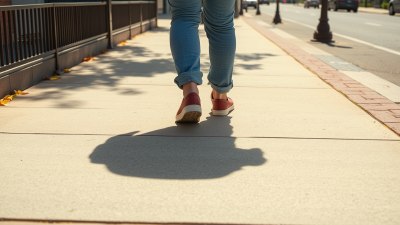How to Survive a Sidewalk That's 20 Degrees Hotter Than the Forecast Said
Learn practical tips and safety measures to handle unexpectedly hot sidewalks and stay safe in extreme heat conditions.

Image created with Flux Schnell
Imagine stepping outside and finding the sidewalk scorching under your feet, much hotter than the day's weather forecast predicted. This common urban scenario can catch anyone off guard, especially during heat waves magnified by the sun's direct reflection on concrete and asphalt. When the sidewalk is 20 degrees hotter than expected, it not only creates discomfort but also poses health risks such as burns, dehydration, and heat exhaustion. Understanding how to adapt and protect yourself in these conditions is essential for safety and comfort.
Why Sidewalks Get Hotter Than the Forecast
Weather forecasts typically provide air temperature readings taken in shaded, ventilated areas about five feet above ground level. However, these do not reveal the ground’s surface temperature that pedestrians experience first-hand. Sidewalks absorb and retain solar radiation, making them significantly hotter than the surrounding air. Materials like concrete and asphalt have high thermal mass and heat conductivity, leading to greater surface temperatures, especially under direct sunlight.
Moreover, urban environments contribute to this effect through what is known as the 'urban heat island' phenomenon. Dense buildings, reduced greenery, and heat-absorbing infrastructure lead to elevated temperatures compared to rural or suburban areas. This can increase sidewalk temperatures well beyond forecasted air temps.
The Risks of Walking on Super-Hot Sidewalks
Exposure to sidewalks heated 20 degrees above the forecast can lead to several hazards. Firstly, there is a risk of foot burns, particularly for those wearing thin-soled shoes, sandals, or for children and pets who are closer to the ground. The sidewalk surface can reach temperatures over 140 degrees Fahrenheit, which can cause blistering upon contact.
Secondly, the intense heat contributes to heat stress and dehydration. Body heat is amplified as heat radiates from the surface, reducing natural cooling via sweat evaporation. Walking on such surfaces in heavy sun can lead to dizziness, fatigue, cramps, or even heat stroke, especially among vulnerable populations such as the elderly, young children, and individuals with pre-existing medical conditions.
Essential Preparation for Hot Sidewalks
To survive and stay comfortable on scorching sidewalks, preparation is key. If higher sidewalk temperatures are expected, or if the forecast ignores ground-level heat, start with clothing and hydration strategies. Wear light-colored, loose-fitting clothing made of breathable fabrics such as cotton or moisture-wicking synthetics to enhance air circulation and sweat evaporation.
Choose footwear with thick soles and closed designs to protect your feet from heat transfer. Shoes made of rubber, leather, or well-insulated materials can prevent burns. Avoid sandals or thin-soled shoes when temperatures are high and the sidewalk is absorbing intense heat.
Hydration cannot be overstated. Drink water before heading out and carry a water bottle to sip frequently. Avoid drinks with caffeine or alcohol as they can dehydrate your body further. Cooling accessories such as hats, umbrellas, or portable fans can provide shade and airflow to reduce heat absorption.
Smart Walking Techniques
Adjust your walking schedule to avoid peak sun hours typically between 10 am and 4 pm. Walk during early mornings or late evenings when temperatures and sidewalk heat are lower. If walking during hotter times is unavoidable, take frequent breaks in shaded areas or indoors to cool down.
Alter your walking path to include shaded routes lined with trees or buildings that cast shadows on sidewalks. Grass or dirt adjacent to sidewalks is usually cooler; when possible, walk on these paths to minimize contact with hot pavement. However, be mindful of safe footing and insects.
Minimize the duration of your outdoor activities to limit exposure. Plan routes that combine multiple errands in the most efficient, shortest path. Use public transportation for longer distances to reduce time spent walking on hot surfaces.
Cooling Strategies Upon Contact
If you must walk barefoot for any reason and encounter burning surfaces, take immediate measures. Suspend walking momentarily to wait for the surface to cool if possible, or quickly move to shaded ground. Rinse feet with cool water as soon as possible to prevent or reduce burns.
In severe cases of burn from hot pavement, applying aloe vera gel or over-the-counter burn creams and seeking medical attention is advised. For pets, limit their exposure outdoors during peak hours and provide water and cooling mats.
Urban Planning and Community Awareness
In the broader perspective, cities and communities can combat hotspot issues by investing in heat-mitigating infrastructure. Using lighter-colored, reflective materials for sidewalks reduces heat absorption. Increasing urban greenery with trees, shrubs, and green walls provides natural shade and cooling.
Public awareness campaigns can inform residents about the risks and prevention strategies related to hot surface exposure. Providing public water stations, shaded rest stops, and cooling centers during heat waves enhances community resilience.
Technology and Innovations for Heat Management
Innovative solutions such as heat-resistant pavements infused with reflective aggregates or cooling coatings have emerged. These technologies have demonstrated temperature reductions on pavement surfaces, lowering the heat burden to pedestrians.
Wearable tech can also assist individuals by monitoring body temperature and exposure time to warn of heat stress risks. Mobile apps providing real-time sidewalk surface temperatures or heat advisory alerts can guide safe walking choices.
Hydration and Nutrition Tips for Heat Survival
Maintaining hydration is essential when dealing with extreme sidewalk heat. Water remains the best choice, but electrolyte-rich fluids can assist in replacing salts lost to sweating. Eating small, light meals rich in fruits and vegetables helps maintain energy without generating excess body heat.
Avoid heavy, spicy, or fried foods during heat exposure, as they require more metabolic energy and could exacerbate heat stress symptoms.
Protecting Vulnerable Individuals
Children, the elderly, pregnant women, and people with chronic illnesses face higher risks from hot sidewalk environments. Caregivers should ensure these groups avoid outdoor activity during intense heat, maintain hydration, wear appropriate clothing, and have access to cooling shelters.
Outdoor workers should follow strict heat safety protocols, including regular breaks in shaded areas, hydration, and wearing protective gear. Employers can help by providing heat safety training and adjusting work schedules seasonally to protect health.
Recognizing Heat-Related Illnesses
Understanding the signs of heat-related illness enables prompt response and treatment. Heat cramps involve painful muscle spasms and are an early warning sign. Heat exhaustion includes symptoms like heavy sweating, weakness, cold or clammy skin, nausea, and fainting.
Heat stroke is a medical emergency characterized by a high body temperature (above 104°F), hot, dry skin, confusion, loss of consciousness, and requires immediate medical intervention.
If you or someone else shows symptoms, move to a cooler environment, hydrate if conscious, and seek medical help immediately.
Adapting Your Lifestyle to Hot Sidewalks
Living in an area prone to extreme sidewalk temperatures calls for ongoing strategies. Adjust your daily habits to prioritize heat safety: plan errands outside of peak sun hours, keep hydration tools handy, and wear sun-protective gear consistently.
Embrace outdoor spaces with cooling design elements, such as parks with water features and adequate shade. Engage in community efforts to advocate for heat-resilient urban planning, including planting trees and installing shade structures along pedestrian routes.
Psychological Effects of Heat and Coping Mechanisms
Extreme heat is not only a physical challenge but also impacts mood and cognitive function. High temperatures can cause irritability, difficulty concentrating, and fatigue. It's important to practice self-care by resting when needed, staying hydrated, and avoiding stressful outdoor activities during intense heat.
Engage in indoor activities during peak heat, use air conditioning or fans to maintain comfort, and monitor yourself and others for heat stress signals.
How to Check Sidewalk Temperature Before Walking
Predicting sidewalk heat can be difficult without proper tools, but there are practical methods. Infrared thermometers give accurate surface temperature readings and can be used to check sidewalks. Some smartphone applications paired with external sensors also measure surface heat.
Alternatively, observing the environment for clues—such as how hot the street signs, car hoods, or playground equipment feel—can indicate surface temperatures. When in doubt, opt for shaded or grassy paths.
Emergency Supplies for Heat Encounters Outdoors
Carrying a small emergency kit can make hot sidewalk encounters safer. Include items such as a portable water bottle, cooling towel, sunscreen, small first aid supplies including burn ointment, and a wide-brimmed hat. These essentials help mitigate heat effects and address minor injuries immediately.
Preparing Pets for Hot Sidewalks
Pets are particularly vulnerable to hot sidewalks due to their proximity to the surface and limited ability to sweat. Always check pavement temperatures with your hand before walking a pet; if it’s too hot for your palm, it’s too hot for their paws.
Walk pets during cooler times, use protective booties, and provide fresh water and shaded resting spots. Avoid leaving pets in parked cars or outdoor enclosures without ventilation or cooling.
Integrating Heat Safety in Daily Routines
Incorporate heat awareness into your daily habits. Regularly check weather and heat advisories, adjust clothing and activity plans accordingly, and educate family and friends about heat risks. Building these routines helps maintain safety even on unexpectedly hot days.
Remember, heat exposure on extremely hot surfaces can sneak up quickly. Staying informed, prepared, and cautious makes all the difference.











